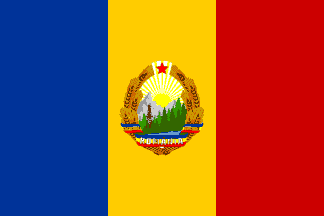Romanian Flag in Danger
by: Carmen & Ciprian
A diplomatic argument over the national colours of two countries belonging to different continents, two different backgrounds and religions: European Christian Romania and the African Islamic Republic of Chad. They argue over their national colours.
Present Flag Romania & Chad
After the endorsement, in 1989, of the Romanian flag without its traditional coat of arms, a diplomatic dispute started between Romania and the Republic of Chad on the matter of what is called in both countries, "the red, the blue and the yellow". The two flags are identical and the argument has been brought to the attention of the United Nations.
The Republic of Chad settled the appearance of its flag in 1959. At that time the Romanian flag included the communist coat of arms. The Becoming of a Flag The Republic of Chad gained its independence in 1959, choosing a red, blue and yellow flag, with the blue at the hoist.
The official site of the republic specifies that the flag is a combination between the blue-white-red that makes the Franch flag (ex-colonizer of Chad) and the green-yellow-red of the Pan- African Republic. The site mentions that "accidentally, the flag is the same as the Romanian one".
The people of Chad say that blue means the sky (hope, agriculture and the southern part of the country), yellow means the desert (the northern part of the country) and red means prosperity, unity and the decision of the citizens to always defend their country.
The three controversial colours appear on other flags also, that of the Moldovian Republic and that of the Principality of Andorra. However, they both have a coat of arms also displayed. Which is not the case, after 1989, with the Romanian flag.
Flag of the People's Republic of Romania
After the December anti-communist revolution, Romanians actually removed the coat of arms but the officials did not agree on having a flag with a hole in the middle, a fact that led to having a flag identical to the one of the Republic of Chad. When the United Nations were notified, the Romanians claimed that the Romanian flag used a different shade of yellow. The proof was hardly acceptable for Chad and during the last decade the dispute has amplified leading to the present risk that the UN may decide that Romanians have to give up their colours.
Almost two hundred years of "red, yellow and blue"
The three colours of the Romanian flag were first used in 1821 during a national revolution. The original flag is kept in the National History Museum of Bucharest. It was made in an old monastery and the coat of arms represented the Holy Trinity and two military saints.
The colours were next used by Romanian students that took part in the 1848 French Revolution. It was than a symbol of the union of three Romanian regions. During the years, the three colours were always part of the Romanian flag. The only thing that changed, in respect to the constitutional status of the country was the coat of arms.
The three colours are highly significant for Romanians. We have learned their meaning since childhood and we can not imagine any Romanian allowing them to be changed. These days, the two country authorities are working on solving this odd dispute.
Which country would ever accept to have its flag taken, its historical symbols removed? And if the United Nations will decide so, which country will have to change the flag, and which will dare to oppose a UN decision?
http://www.fotw.stm.it/flags/td.html
http://fotw.vexillum.com/flags/ro.html
Sites on Romania and the Republic of Chad
http://www.cia.gov
http://www.sesrtcic.org/members

















